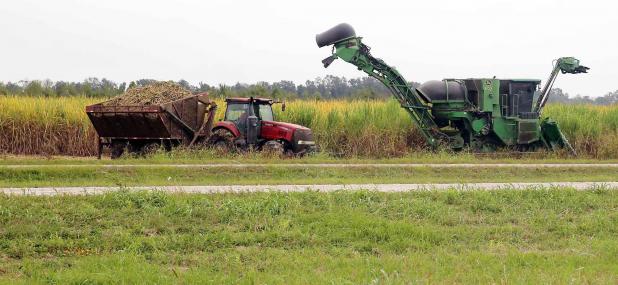
The Review/Bill Decker
Work is underway in this sugar cane field along U.S. 90 west of Baldwin.
Cane farmers get an assist from the weather
A few weeks of dry weather are giving St. Mary sugar cane farmers a break, although it's a working break.
After what experts called a great 2020 cane crop, farmers have worried their way through a hard freeze in February, pushed machinery through mud created by months of heavy rain and watched with trepidation while tropical weather approached.
But this month, “the two to three weeks of dry weather have been our longest and best span of good weather all year,” said Kenneth Gravois, the LSU AgCenter’s sugar cane specialist.
Lots of late planting has been going on as growers finish planting some of their clay ground, Gravois wrote in an email.
“Clay soils have shorter windows of opportunity for drying out and being planted,” he wrote. “So, this dry spell has allowed for growers to finish.
“Not ideal, but those were the conditions we faced in 2021.”
St. Mary has lots of clay soils, Gravois wrote, “so late planting there as well. St. Mary was on the edge of the hurricane and not severely affected by the winds of Hurricane Ida.”
According to statistics from the American Sugar Cane League in Thibodaux, approximately 463,000 acres of cane were harvested by 417 farms in Louisiana in 2020. With an average of 8,568 pounds of sugar produced per acre, 2020 was a stellar year for the industry, the AgCenter said in a press release.
This year’s crop, by contrast, endured a damp, challenging growing season. Now, harvest is getting off to a soggy start.
Gravois said rainy weather leading up to this year’s 90-day harvest slowed down many aspects of farmers’ and millers’ operations.
“When you’re in muddy fields, it’s just a more expensive crop to harvest,” Gravois said. “You’re burning more diesel. It’s harder to clean the cane. It’s just not good for anybody.”
The cloudy, wet spring and early summer that farmers experienced during the prime sugarcane-growing season may have led to lower stalk density across the sugar belt. This translates to lower tonnage yields as the harvest reaches the scales at the state’s 11 sugar factories.
Sugar cane is grown in 24 parishes throughout southern and central Louisiana. Different areas of the state’s sugar belt have experienced various challenges during 2021. The crop’s annual value in Louisiana alone is approaching $1 billion.
AgCenter agent Renee Castro has monitored the sugar cane crop in the region most heavily battered by Hurricane Ida: the River Parishes of St. James, St. John the Baptist, St. Charles, Ascension, Assumption, and south to Lafourche and Terrebonne parishes. There, Ida’s winds lodged about a quarter of Louisiana’s sugarcane crop, but cooperative growing conditions have helped straighten the tangled stalks, Castro said.
According to AgCenter data, about 139,000 acres of cane are expected to have somewhat lower sugar yields because of the storm.
“I think they’ll still be able to get in there and do what they need to do, but it will be with lesser yields at the mills,” Castro predicted.
“I was in this area yesterday,” Gravois wrote, referring to the area east of St. Mary.
“Hurricane Ida was not kind to the cane crop in Terrebonne, Lafourche, St. James, St. John the Baptist and St. Charles parishes. Early harvesting data suggests light tonnage (tons of cane/acre) but good sugar recoveries. Each day we learn more.”
